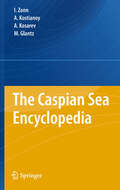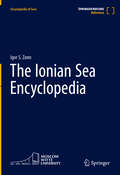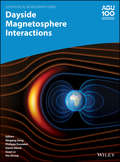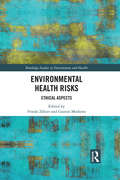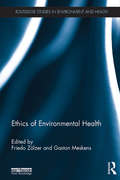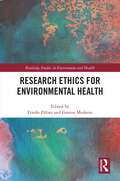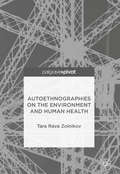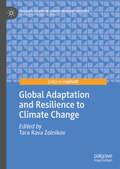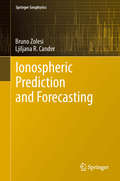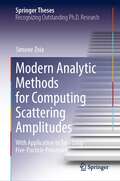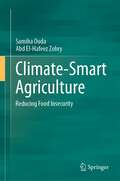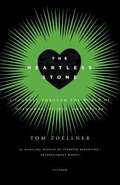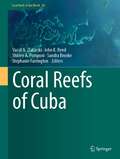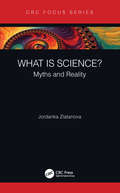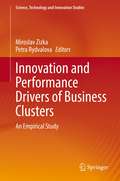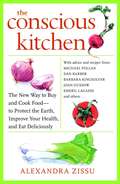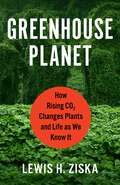- Table View
- List View
The Caspian Sea Encyclopedia (Encyclopedia of Seas)
by Igor S. Zonn Aleksey N Kosarev Michael Glantz Andrey G. Kostianoy“The Caspian Sea Encyclopedia” is the second one in the new series of encyclo- dias about the seas of the former Soviet Union published by Springer-Verlag. The ?rst volume – “The Aral Sea Encyclopedia” was published by Springer in 2009. The series will be continued by “The Black Sea Encyclopedia” in 2010. Today the Caspian Sea is known to readers thanks to its oil and gas resources, sturgeon and caviar, signi?cant sea-level variations, socio-economic and political problems. The Caucasus and Central Asia (http://eurodialogue. org/?les/fckeditor_?les/Caspian-s- map2. png) vii viii Introduction For more than 250 years the Caspian Sea was shared by two states: Russia (the Soviet Union) and Persia (Iran). After the disintegration of the USSR in 1992, the new independent states of Azerbaijan, Turkmenistan and Kazakhstan have radically changed the political and economic situation in the region. In addition to Russia and Iran, who had determined the situation on the Caspian for a long period, Azerbaijan, Turkmenistan and Kazakhstan are now interested parties, beginning a new stage in the historical development of the Caspian region. This increase in the number of the Caspian legal entities from two to ?ve has given rise to a whole tangle of geopolitical, economic, international legal, ethnic and environmental problems, each of which demands its own approach and settlement mechanism.
The Ionian Sea Encyclopedia (Encyclopedia of Seas)
by Igor S. ZonnThe book is dedicated to the Ionian Sea, which is part of the Mediterranean. The encyclopedia contains about 600 articles on the hydrographic and geographic objects, hydrological features of the sea, biological resources, as well as administrative-territorial units of the Ionian countries. The most significant natural objects like islands, peninsulas, bays, rivers, mountains, their geographical peculiarities are briefly described as well as economy, culture and history, cities, ports, international agreements, research institutions, activities of outstanding scientists, researchers, travelers are presented in the publication. The chronology of the main historical events that have become significant landmarks in the history of discovery and exploration of the Ionian Sea from the 31 B.C. to the present day is given.
Dayside Magnetosphere Interactions (Geophysical Monograph Series #249)
by Qiugang Zong Philippe Escoubet David Sibeck Guan Le Hui ZhangExploring the processes and phenomena of Earth’s dayside magnetosphere Energy and momentum transfer, initially taking place at the dayside magnetopause, is responsible for a variety of phenomenon that we can measure on the ground. Data obtained from observations of Earth’s dayside magnetosphere increases our knowledge of the processes by which solar wind mass, momentum, and energy enter the magnetosphere. Dayside Magnetosphere Interactions outlines the physics and processes of dayside magnetospheric phenomena, the role of solar wind in generating ultra-low frequency waves, and solar wind-magnetosphere-ionosphere coupling. Volume highlights include: Phenomena across different temporal and spatial scales Discussions on dayside aurora, plume dynamics, and related dayside reconnection Results from spacecraft observations, ground-based observations, and simulations Discoveries from the Magnetospheric Multiscale Mission and Van Allen Probes era Exploration of foreshock, bow shock, magnetosheath, magnetopause, and cusps Examination of similar processes occurring around other planets The American Geophysical Union promotes discovery in Earth and space science for the benefit of humanity. Its publications disseminate scientific knowledge and provide resources for researchers, students, and professionals.
Environmental Health Risks: Ethical Aspects (Routledge Studies in Environment and Health)
by Friedo Zölzer Gaston MeskensEnvironmental health involves the assessment and control of environmental factors that can potentially affect human health, such as radiation, toxic chemicals and other hazardous agents. It is less commonly understood that environmental health also requires addressing questions of an ethical nature. Bringing together work from experts across a range of sub-disciplines of environmental health, this collection of essays discusses the ethical implications of environmental health research and its application, presented at the 3rd International Symposium on Ethics of Environmental Health held in August 2016 in the Czech Republic. In doing so, it builds upon the insights and ideas put forward in the first volume of Ethics of Environmental Health, published by Routledge in early 2017. This volume will be of great interest to students and scholars of environmental health, applied ethics, environmental ethics, medical ethics and bioethics, as well as those concerned with public health, environmental studies, toxicology and radiation.
Ethics of Environmental Health (Routledge Studies in Environment and Health)
by Friedo Zölzer Gaston MeskensEnvironmental health encompasses the assessment and control of those environmental factors that can potentially affect human health, such as radiation, toxic chemicals and other hazardous agents. It is often assumed that the assessment part is just a matter of scientific research, and the control part a matter of implementing standards which unambiguously follow from that research. But it is less commonly understood that environmental health also requires addressing questions of an ethical nature. How can we determine the "acceptable" risk level for the general population or for certain groups? How should we deal with uneven distributions of risks and benefits? How do we communicate about risks with the stakeholders? This multidisciplinary collection brings together a number of leading researchers and scholars in order to generate discussion surrounding these key questions, and to bring the ethical implications of science and technology to the forefront of critical thought. Providing a broad overview of the Ethics of Environmental Health, its philosophical foundations and practical applications, this book offers a significant contribution to ongoing discussions in sustainable development and will be of interest to scholars and practitioners of Environmental Health, urban studies and healthcare.
Research Ethics for Environmental Health (Routledge Studies in Environment and Health)
by Friedo ZölzerResearch Ethics for Environmental Health explores the ethical basis of environmental health research and related aspects of risk assessment and control. Environmental health encompasses the assessment and control of those environmental factors that can potentially affect human health, such as radiation, toxic chemicals and other hazardous agents. It is often assumed that the assessment part is just a matter of scientific research, and that control is a matter of implementing standards that unambiguously follow from that research. But it is less commonly understood that environmental health also requires addressing questions of an ethical nature. Coming from multiple disciplines and nine different countries, the contributors to this book critically examine a diverse range of ethical concerns in modern environmental health research. This book will be of great interest to scholars and practitioners of environmental health, as well as researchers in applied ethics, environmental ethics, medical ethics, bioethics and those concerned with chemical and radiation protection.
Autoethnographies on the Environment and Human Health
by Tara Rava ZolnikovThis book explores the link between individual lives and significant environmental issues affecting millions of people around the world. Zolnikov offers a novel perspective on the environment and human health through autoethnographic stories. Each chapter includes an overview of an environmental risk factor or issue, such as air quality, accompanied by a reflective personal story. Her experiences were gathered around the world and revolve around immersion into local cultures. Learning about environmental health through this qualitative approach will enable readers to understand how issues in the environment are currently affecting people on an individual basis.
Global Adaptation and Resilience to Climate Change (Palgrave Studies In Climate Resilient Societies Ser.)
by Tara Rava ZolnikovThis book explores the link between climate change and resiliency on each continent of the world. It reviews how climate change affects populations, not only through environmental exposures and health outcomes, but how people live their lives. Zolnikov brings together a set of experts to offer a novel perspective on understanding climate change vulnerability alongside adaption measures being implemented. Each chapter includes an overview on how climate change will affect that continent alongside current adaptation, mitigation, and policies that seek to improve population outcomes. As a whole, the book explores why a “one size fits all” approach to promote climate change resiliency does not work; however, a global perspective can facilitate people learning from one another and facing climate change together.
Ionospheric Prediction and Forecasting
by Bruno Zolesi Ljiljana R. CanderThis book describes how to predict and forecast the state of planet Earth's ionosphere under quiet and disturbed conditions in terms of dynamical processes in the weakly ionized plasma media of the upper atmosphere and their relation to available modern measurements and modelling techniques. It explains the close relationship between the state of the media and the radio wave propagation conditions via this media. The prediction and forecasting algorithms, methods and models are oriented towards providing a practical approach to ionospherically dependent systems design and engineering. Proper understanding of the ionosphere is of fundamental practical importance because it is an essential part of telecommunication and navigation systems that use the ionosphere to function or would function much better in its nonappearance on the Earth and on any planet with an atmosphere.
Modern Analytic Methods for Computing Scattering Amplitudes: With Application to Two-Loop Five-Particle Processes (Springer Theses)
by Simone ZoiaThis work presents some essential techniques that constitute the modern strategy for computing scattering amplitudes. It begins with an introductory chapter to fill the gap between a standard QFT course and the latest developments in the field. The author then tackles the main bottleneck: the computation of the loop Feynman integrals. The most efficient technique for their computation is the method of the differential equations. This is discussed in detail, with a particular focus on the mathematical aspects involved in the derivation of the differential equations and their solution. Ample space is devoted to the special functions arising from the differential equations, to their analytic properties, and to the mathematical techniques which allow us to handle them systematically. The thesis also addresses the application of these techniques to a cutting-edge problem of importance for the physics programme of the Large Hadron Collider: five-particle amplitudes at two-loop order. It presents the first analytic results for complete two-loop five-particle amplitudes, in supersymmetric theories and QCD. The techniques discussed here open the door to precision phenomenology for processes of phenomenological interest, such as three-photon, three-jet, and di-photon + jet production.
Climate-Smart Agriculture: Reducing Food Insecurity
by Abd El-Hafeez Zohry Samiha OudaThis book tackles the main feature of water-smart, soil-smart and crop-smart practices and their integration to sustainably enhance food production. The book includes some insights on the implications of using climate-smart practices in irrigated and rain-fed agriculture, and suggests approaches to eradicate the negative effects of water scarcity, climate variability and climate change. The book reviews the most important crops resilient to climate variability and their resistance to other biotic and abiotic stresses, and contains the existing practices in Egypt that achieved the three pillars of climate-smart agriculture
The Heartless Stone: A Journey Through the World of Diamonds, Deceit, and Desire
by Tom ZoellnerAn American Library Association Notable Book. When he proposed to his girlfriend, Tom Zoellner gave what is expected of every American man--a diamond engagement ring. But when the relationship broke apart, he was left with a used diamond that began to haunt him. His obsession carried him around the globe; from the "blood diamond" rings of Africa; to the sweltering polishing factories of India; to mines above the Arctic Circ to illegal diggings in Brazil; to the London headquarters of De Beers, the secretive global colossus that has dominated the industry for more than a century and permanently carved the phrase "A diamond is forever" on the psyche. An adventure story in the tradition of Susan Orlean's The Orchid Thief, The Heartless Stone is a voyage into the cold heart of the world's most unyielding gem.
How Mountains Are Made
by Kathleen Weidner Zoehfeld James Graham HaleEven though Mount Everest measures 29,028 feet high, it may be growing about two inches a year. A mountain might be thousands of feet high, but it can still grow taller or shorter each year. Mountains are created when the huge plates that make up the earth's outer shell very slowly pull and push against one another. Read and find out about all the different kinds of mountains.
How Deep Is the Ocean? (Let's-Read-and-Find-Out Science 2)
by Kathleen Weidner ZoehfeldRead and find out about the deepest part of the ocean in this colorfully illustrated nonfiction picture book.The ocean covers almost three-quarters of the Earth, but how deep does it go? Put on your scuba gear and explore the ocean, from its shallowest waters to its deepest, most mysterious parts. As you dive deeper, you’ll discover glowing animals, strange creatures that don’t need sunlight to survive, and even the largest hunter in the world.With beautiful illustrations and engaging text, How Deep Is the Ocean? will guide young readers into the deepest parts of the ocean. Featuring a find-out-more section with a water-pressure experiment, a lesson in making a sounding line to learn how scientists measure the depth of the ocean, a glossary of new terms, and web research prompts, this book will begin children’s explorations of the deep sea. Both the text and the artwork were vetted for accuracy by Dr. David Gruber, real-life deep sea explorer and professor of biology and environmental science at Baruch College.This is a clear and appealing science book for early elementary age kids, both at home and in the classroom. It's a Level 2 Let's-Read-and-Find-Out, which means the book explores more challenging concepts for children in the primary grades. The 100+ titles in this leading nonfiction series are:hands-on and visualacclaimed and trustedgreat for classroomsTop 10 reasons to love LRFOs:Entertain and educate at the same timeHave appealing, child-centered topicsDevelopmentally appropriate for emerging readersFocused; answering questions instead of using survey approachEmploy engaging picture book quality illustrationsUse simple charts and graphics to improve visual literacy skillsFeature hands-on activities to engage young scientistsMeet national science education standardsWritten/illustrated by award-winning authors/illustrators & vetted by an expert in the fieldOver 130 titles in print, meeting a wide range of kids' scientific interestsBooks in this series support the Common Core Learning Standards, Next Generation Science Standards, and the Science, Technology, Engineering, and Math (STEM) standards. Let's-Read-and-Find-Out is the winner of the American Association for the Advancement of Science/Subaru Science Books & Films Prize for Outstanding Science Series.
How Mountains Are Made (Let's-Read-and-Find-Out Science 2)
by Kathleen Weidner ZoehfeldRead and find out about how mountains are made in this colorfully illustrated nonfiction picture book.A mountain might be thousands of feet high, but it can still grow taller or shorter each year. This classic picture book explores how mountains are made—including how Mount Everest grew from a flat plain under an ocean to become 29,028 feet tall.How Mountains Are Made features simple activities and fascinating cross-sections of the earth’s moving crust that clearly explain plate tectonics. Both text and artwork were vetted for accuracy by an expert in the field.This is a clear and appealing science book for early elementary age kids, both at home and in the classroom. It's a Level 2 Let's-Read-and-Find-Out, which means the book explores more challenging concepts for children in the primary grades. The 100+ titles in this leading nonfiction series are:hands-on and visualacclaimed and trustedgreat for classroomsTop 10 reasons to love LRFOs:Entertain and educate at the same timeHave appealing, child-centered topicsDevelopmentally appropriate for emerging readersFocused; answering questions instead of using survey approachEmploy engaging picture book quality illustrationsUse simple charts and graphics to improve visual literacy skillsFeature hands-on activities to engage young scientistsMeet national science education standardsWritten/illustrated by award-winning authors/illustrators & vetted by an expert in the fieldOver 130 titles in print, meeting a wide range of kids' scientific interestsBooks in this series support the Common Core Learning Standards, Next Generation Science Standards, and the Science, Technology, Engineering, and Math (STEM) standards. Let's-Read-and-Find-Out is the winner of the American Association for the Advancement of Science/Subaru Science Books & Films Prize for Outstanding Science Series.
Secrets of the Seasons: Orbiting the Sun in Our Backyard
by Kathleen Weidner ZoehfeldThe family from Secrets of the Garden are back in a new book about backyard science that explains why the seasons change.Alice and her friend Zack explore the reasons for the seasons. Alice's narrative is all about noticing the changes as fall turns into winter, spring, and then summer. She explains how the earth's yearlong journey around the sun, combined with the tilt in the earth's axis, makes the seasons happen. Alice's text is clear and simple, and experiential. Two very helpful—and very funny—chickens give more science details and further explanation through charts, diagrams, and sidebars. Packed with sensory details, humor, and solid science, this book makes a complicated concept completely clear for young readers—and also for the many parents who struggle to answer their kids' questions! "Several adults of my acquaintance . . . would find Secrets of the Seasons to be an eye-popping revelation." —John Lithgow, The New York Times Book Review
What Is the World Made Of?: All About Solids, Liquids, and Gases (Let's-Read-and-Find-Out Science 2)
by Kathleen Weidner ZoehfeldRead and find out about the three states of matter—solid, liquid, and gas—in this colorfully illustrated nonfiction picture book.Can you make an ice cube disappear? Put it on a hot sidewalk. It melts into water and then vanishes! The ice cube changes from solid to liquid to gas. This Level 2 Let's-Read-and-Find-Out picture book is a fascinating exploration of the three states of matter.This clear and appealing science book for early elementary age kids, both at home and in the classroom, uses simple, fun diagrams to explain the difference between solids, liquids, and gases. This book also includes a find out more section with experiments designed to encourage further exploration and introduce record keeping.This is a Level 2 Let's-Read-and-Find-Out, which means the book explores more challenging concepts for children in the primary grades. The 100+ titles in this leading nonfiction series are:hands-on and visualacclaimed and trustedgreat for classroomsTop 10 reasons to love LRFOs:Entertain and educate at the same timeHave appealing, child-centered topicsDevelopmentally appropriate for emerging readersFocused; answering questions instead of using survey approachEmploy engaging picture book quality illustrationsUse simple charts and graphics to improve visual literacy skillsFeature hands-on activities to engage young scientistsMeet national science education standardsWritten/illustrated by award-winning authors/illustrators & vetted by an expert in the fieldOver 130 titles in print, meeting a wide range of kids' scientific interestsBooks in this series support the Common Core Learning Standards, Next Generation Science Standards, and the Science, Technology, Engineering, and Math (STEM) standards. Let's-Read-and-Find-Out is the winner of the American Association for the Advancement of Science/Subaru Science Books & Films Prize for Outstanding Science Series.
What Lives in a Shell? (Let's-Read-and-Find-Out Science 1)
by Kathleen Weidner ZoehfeldRead and find out about what lives in a shell in this colorfully illustrated nonfiction picture book.A house is a home for you, a nest is a home for a bird, and a cave is a home for a bear. But for some animals a shell is a home. Snails and turtles and crabs and clams all have shells that act as their homes and protect them from harm.This clear and appealing book for early elementary age kids, both at home and in the classroom, is a fascinating exploration of the many creatures that make a home in a shell. This picture book features beautifully accurate illustrations of the many types of shells—inside and out! Young readers will love exploring the fascinating homes of creatures like hermit crabs, scallops, and turtles.This is a Level 1 Let's-Read-and-Find-Out, which means the book explores introductory concepts perfect for children in the primary grades. The 100+ titles in this leading nonfiction series are:hands-on and visualacclaimed and trustedgreat for classroomsTop 10 reasons to love LRFOs:Entertain and educate at the same timeHave appealing, child-centered topicsDevelopmentally appropriate for emerging readersFocused; answering questions instead of using survey approachEmploy engaging picture book quality illustrationsUse simple charts and graphics to improve visual literacy skillsFeature hands-on activities to engage young scientistsMeet national science education standardsWritten/illustrated by award-winning authors/illustrators & vetted by an expert in the fieldOver 130 titles in print, meeting a wide range of kids' scientific interestsBooks in this series support the Common Core Learning Standards, Next Generation Science Standards, and the Science, Technology, Engineering, and Math (STEM) standards. Let's-Read-and-Find-Out is the winner of the American Association for the Advancement of Science/Subaru Science Books & Films Prize for Outstanding Science Series.
What Makes a Blizzard? (Let's-Read-and-Find-Out Science 2)
by Kathleen Weidner ZoehfeldRead and find out about blizzards in this colorfully illustrated nonfiction picture book.All blizzards are snowstorms, but not all snowstorms are blizzards. What is the difference? How much snow falls during a blizzard? How fast are the winds? How cold does it get during a blizzard? Read and find out! What Makes a Blizzard comes chock-full of visual aids like charts, sidebars, and hands-on activities—including how to keep a winter weather journal and how to observe what a snowflake really looks like.This is a clear and appealing science book for early elementary age kids, both at home and in the classroom. It's a Level 2 Let's-Read-and-Find-Out, which means the book explores more challenging concepts for children in the primary grades. The 100+ titles in this leading nonfiction series are:hands-on and visualacclaimed and trustedgreat for classroomsTop 10 reasons to love LRFOs:Entertain and educate at the same timeHave appealing, child-centered topicsDevelopmentally appropriate for emerging readersFocused; answering questions instead of using survey approachEmploy engaging picture book quality illustrationsUse simple charts and graphics to improve visual literacy skillsFeature hands-on activities to engage young scientistsMeet national science education standardsWritten/illustrated by award-winning authors/illustrators & vetted by an expert in the fieldOver 130 titles in print, meeting a wide range of kids' scientific interestsBooks in this series support the Common Core Learning Standards, Next Generation Science Standards, and the Science, Technology, Engineering, and Math (STEM) standards. Let's-Read-and-Find-Out is the winner of the American Association for the Advancement of Science/Subaru Science Books & Films Prize for Outstanding Science Series.
Reservoir Geomechanics
by Mark D. ZobackA practical reference for geoscientists and engineers in the petroleum and geothermal industries.
Coral Reefs of Cuba (Coral Reefs of the World #18)
by Vassil N. Zlatarski John K. Reed Shirley A. Pomponi Sandra Brooke Stephanie FarringtonThis comprehensive volume gathers foremost experts on the coral reefs of Cuba who represent a spectrum of disciplines, including biology, conservation ecology, economics and geology. The volume is organized along general themes including the Cuban Reef biota, reefs occurring in the Mesophotic and Eutrophic zones, ecology, conservation, management and the economic importance of the coral reefs of Cuba. The combination of case studies, new and previously published research, historical overview and examples of the ways in which research has contributed to the management and conservation of Cuban coastal resources provides a unique reference for graduate students and professionals holding a wide range of interests and expertise related to coral reef systems.
What is Science?: Myths and Reality
by Jordanka ZlatanovaIn a multitude of ways, science affects the life of almost every person on earth. From medicine and nutrition to communication and transportation, the products of scientific research have changed human life. These changes have mostly taken place in the last two centuries, so rapidly that the average person is unable to keep informed. A consequence of this "information gap" has been the increasing suspicion of science and scientists. The lack of true understanding of science, especially of "fundamental" research, motivates this effort to narrow this gap by explaining scientific endeavor and the data-driven worldviews of scientists. Key Features Fills an existing void in the understanding of science among the general population Is written in a nontechnical language to facilitate understanding Covers a wide range of science-related subjects: The value of "basic research" How scientists work by sharing results and ideas How science is funded by governments and private entities Addresses the possible dangers of research and how society deals with such risks Expresses the viewpoint of an author with extensive experience working in laboratories all over the world
Innovation and Performance Drivers of Business Clusters: An Empirical Study (Science, Technology and Innovation Studies)
by Miroslav Zizka Petra RydvalovaThis book highlights the importance of clusters for the competitiveness of companies and is divided into three interrelated parts. The first part focuses on localization economics, cluster theory, the role of innovation, and innovation partnerships in cluster formations. The second part of the volume presents original research carried out from 2018 to 2020 in the field of both natural clusters and organized clusters. In addition to examining the impact of cluster membership, the contributions also focus on additional factors that may affect the financial performance of companies. In the third part, an additional survey and case studies are presented, to examine the specifics of family businesses in selected industrial districts of the textile, glass, and jewelry industries. A broader overview of the development of dominant industries in the selected districts is provided, for an easier understanding of the relationships of competition among companies and locations in the business clusters. The book evaluates implications for microeconomic and macroeconomic policies and provides proposals for corporate inter-organizational behavior.This volume addresses scholars and researchers of economics, business, and management, as well as policy-makers and practitioners interested in a better understanding of innovation and performance drivers of business clusters.
The Conscious Kitchen: The New Way to Buy and Cook Food - to Protect the Earth, Improve Your Health, and Eat Deliciously
by Alexandra ZissuYour everyday food choices can change the world--and make meals taste better than ever For anyone who has read The Omnivore's Dilemma or seen Food, Inc. and longs to effect easy green changes when it comes to the food they buy, cook, and eat, The Conscious Kitchen is an invaluable resource filled with real world, practical solutions. Alexandra Zissu walks readers through every kitchen-related decision with three criteria in mind: what's good for personal health, what's good for the planet, and what tastes great. Learn, among other things, how to: - Keep pesticides, chemicals, and other harmful ingredients out of your diet- Choose when to spend your dollars on organic fruit and when to buy conventionally grown- Avoid plastic--including which kinds in particular and why- Figure out what seafood is safe to eat and is sustainable- Use COOL (country of origin labels) to your advantage- Determine if a vegetable is genetically modified just from reading its PLU (price look up) code- Decipher meat labels in the supermarket- Cook using the least energy--good for the earth and your wallet- Eat locally, even in winter - Understand what "natural" and other marketing terms really mean- Buy packaged foods wisely Navigate farmers' markets, giant supermarkets, and every shop in between to find the freshest and healthiest local ecologically grown and produced meat, dairy, fruits, and vegetables--no matter where you live With The Conscious Kitchen as your guide, you will never again stand in the market bewildered, wondering what to buy. You can feel confident you are making the best possible choices for you, your family, and our planet. ALEXANDRA ZISSU writes about green living, food, and parenthood. She is the author of The Conscious Kitchen, coauthor of The Complete Organic Pregnancy, and contributes the "Ask an Organic Mom" column to The DailyGreen.com. Her stories have appeared in The New York Times, The Green Guide, Cookie, Details, Bon Appétit, Self, and Health, among other publications. She is also a public speaker and "greenproofer," an eco-lifestyle consultant. Visit her website, www.alexandrazissu.com.
Greenhouse Planet: How Rising CO2 Changes Plants and Life as We Know It
by Lewis H. ZiskaThe carbon dioxide that industrial civilization spews into the atmosphere has dramatic consequences for life on Earth that extend beyond climate change. CO2 levels directly affect plant growth, in turn affecting any kind of life that depends on plants—in other words, everything.Greenhouse Planet reveals the stakes of increased CO2 for plants, people, and ecosystems—from crop yields to seasonal allergies and from wildfires to biodiversity. The veteran plant biologist Lewis H. Ziska describes the importance of plants for food, medicine, and culture and explores the complex ways higher CO2 concentrations alter the systems on which humanity relies. He explains the science of how increased CO2 affects various plant species and addresses the politicization and disinformation surrounding these facts.Ziska confronts the claim that “CO2 is plant food,” a longtime conservative talking point. While not exactly false, it is deeply misleading. CO2 doesn’t just make “good” plants grow; it makes all plants grow. It makes poison ivy more poisonous, kudzu more prolific, cheatgrass more flammable. CO2 stimulates some species more than others: weeds fare particularly well and become harder to control. Many crops grow more abundantly but also become less nutritious. And the further effects of climate change will be formidable.Detailing essential science with wit and panache, Greenhouse Planet is an indispensable book for all readers interested in the ripple effects of increasing CO2.
